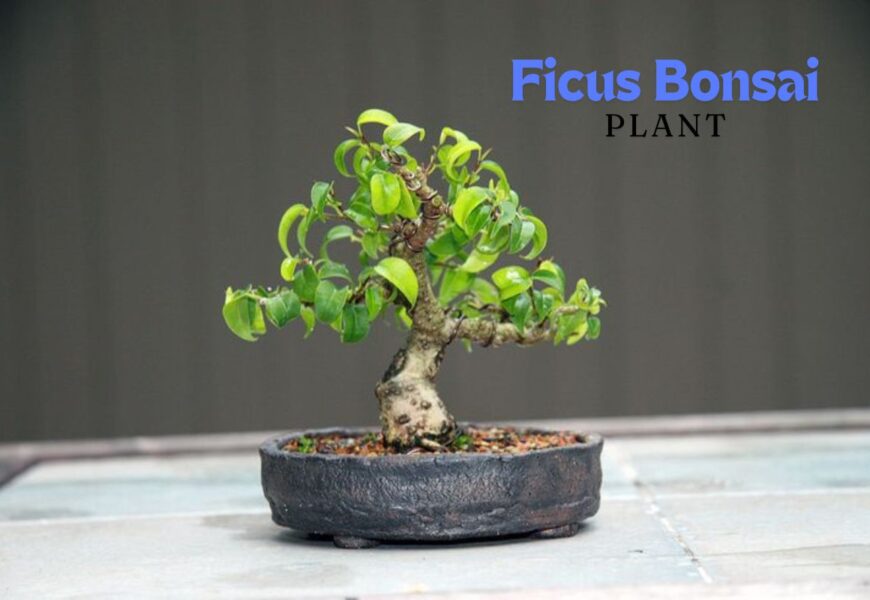Introduction to Ficus Bonsai
The ficus bonsai plant is a popular choice for beginners due to its resilience and adaptability. Its thick trunk and glossy leaves make it both attractive and easy to care for indoors. Varieties like Ginseng and Microcarpa are admired for their unique root structures and compact growth. They can be styled creatively, appealing to bonsai enthusiasts at any level. With proper care, a Ficus bonsai can thrive for decades as a beautiful decorative centerpiece.
Types of Ficus Bonsai
Ficus bonsai comes in several varieties, each with distinct traits that appeal to different growers. While they all share durability and adaptability, their appearances vary, offering unique styling possibilities. Some are best suited for indoor environments, while others can adapt to outdoor conditions in warmer climates. Here are the most popular types:
- Ginseng Ficus – Recognized for its thick, bulbous roots and oval, dark-green leaves.
- Ficus Microcarpa – Known for dense foliage and graceful aerial roots that enhance bonsai aesthetics.
- Other Varieties (e.g., Ficus Retusa, Ficus Benjamina) – Valued for their curved trunks, glossy leaves, and ability to be shaped into creative bonsai forms.
Light Requirements for Ficus Bonsai
Ficus bonsai plants thrive in bright, indirect sunlight, which helps them maintain healthy foliage and strong growth. While they can tolerate lower light conditions, insufficient light often leads to leaf drop and weak stems. Placing them near a south- or east-facing window is ideal for indoor growth. If natural light is limited, grow lights can be used to supplement their needs. Consistent exposure to the right amount of light ensures a compact, vibrant, and well-shaped bonsai.
Soil and Potting Needs
The right soil mix is crucial for keeping a Ficus bonsai healthy and thriving. It should be well-draining to prevent waterlogging, which can quickly lead to root rot. A blend of bonsai soil with akadama, pumice, and organic matter works best for balancing moisture and aeration. The pot should also have drainage holes to ensure excess water can escape easily. Using the proper soil and pot combination creates a strong foundation for long-term growth.
Watering Your Ficus Bonsai
Watering is one of the most important aspects of caring for a Ficus bonsai, as both overwatering and underwatering can harm the plant. The soil should be kept slightly moist, but never soggy, to support healthy root function. A good rule is to water thoroughly once the top layer of soil begins to feel dry. During hot summer months, the plant may need more frequent watering, while in winter, watering should be reduced. Consistent and mindful watering keeps the bonsai strong and vibrant.
Temperature and Humidity
Ficus bonsai plants prefer warm, stable temperatures that mimic their tropical origins. Ideally, they should be kept between 60–75°F (15–24°C) to support steady growth. Sudden drafts, cold temperatures, or exposure to heating vents can stress the plant and cause leaf drop. Humidity is equally important, as dry air can weaken the bonsai over time. Using a humidity tray or occasional misting helps maintain the moisture levels it needs to stay healthy and lush.
Fertilizing for Healthy Growth
Regular fertilization ensures that a Ficus bonsai receives the nutrients it needs to thrive in a limited pot environment. A balanced liquid bonsai fertilizer applied every two to four weeks during the growing season supports leaf development and root strength. In winter, feeding should be reduced as the plant’s growth slows down. Organic fertilizers can also be used to promote long-term soil health. With proper feeding, your bonsai will maintain lush foliage and strong structural growth.
Pruning and Shaping Your Bonsai
Pruning is essential for maintaining the compact size and artistic form of a Ficus bonsai. Regular trimming encourages new growth and helps the plant develop a balanced structure. Seasonal pruning allows you to refine the shape, while careful wiring can guide branches into desired positions. Always use clean, sharp tools to prevent damage or infection. With consistent pruning and shaping, your bonsai will remain healthy and aesthetically pleasing.
Training and Styling Techniques
Training a Ficus bonsai involves guiding its growth to achieve a miniature tree that looks natural and balanced. Techniques such as wiring, branch bending, and selective pruning are commonly used to create the desired shape. It’s important to train gradually, as forcing branches can cause breakage or long-term damage. Keeping bonsai tools clean and sharp ensures precise cuts and prevents disease spread. With patience and creativity, styling a Ficus bonsai becomes both an art and a rewarding process.
Repotting Your Ficus Bonsai
Repotting a Ficus bonsai plant is necessary to refresh the soil and prevent roots from becoming pot-bound, which can stunt growth. Typically, a Ficus bonsai should be repotted every two to three years during the spring season. When repotting, prune away any circling or excess roots to encourage a healthier root system. Always use fresh, well-draining bonsai soil to provide renewed nutrients and proper aeration. Repotting not only supports long-term health but also helps maintain the bonsai’s size and balance.
Propagation Methods
Propagating a Ficus bonsai allows you to grow new plants and expand your collection with ease. The most common methods are stem cuttings and air layering, both of which produce reliable results. Cuttings should be taken from healthy branches and rooted in moist soil under warm conditions. Air layering, though slower, helps develop strong roots while still attached to the parent plant. With patience and proper care, propagation ensures a continuous supply of thriving bonsai.
Cleaning and Leaf Care
Keeping the leaves of a Ficus bonsai clean is vital for its overall health and appearance. Dust buildup can block sunlight and reduce the plant’s ability to photosynthesize efficiently. Gently wiping the leaves with a damp cloth or misting them helps maintain their glossy look. Regular cleaning also prevents pests from hiding on the foliage. A well-maintained bonsai not only looks beautiful but also stays healthier and more resilient.
Common Pests and Diseases
Like many indoor plants, Ficus bonsai can occasionally suffer from pests and diseases. Common insects include spider mites, scale, and aphids, which feed on sap and weaken the plant. Fungal issues, such as leaf spots or root rot, often result from excess moisture and poor airflow. Regular inspection of leaves and stems helps detect problems early before they spread. Prompt treatment with insecticidal soap or fungicide keeps the bonsai healthy and thriving.
Troubleshooting Common Problems
Ficus bonsai may show signs of stress through leaf drop, yellowing, or wilting, often caused by improper watering or sudden environmental changes. Overwatering is a frequent issue, leading to root rot and weak growth. Insufficient light can also cause sparse foliage and leggy branches. Monitoring conditions closely and making gradual adjustments helps the plant recover quickly. Addressing problems early ensures your bonsai remains healthy and attractive year-round.
Benefits of Growing a Ficus Bonsai
Keeping a Ficus bonsai offers both aesthetic and practical benefits for your home or workspace. Its lush green leaves help purify indoor air by filtering toxins and improving oxygen levels. The calming presence of a bonsai is known to reduce stress and promote relaxation. As a decorative piece, it enhances any interior design while adding a touch of nature indoors. Additionally, caring for a bonsai can boost focus, creativity, and mindfulness in daily life.
Symbolism and Cultural Significance
The Ficus bonsai plant holds deep symbolism in many cultures, often representing strength, resilience, and harmony with nature. In Asian traditions, it is admired for its ability to balance beauty with endurance, making it a symbol of peace and wisdom. Many people also associate bonsai with patience and mindfulness, as shaping the tree requires time and care. In homes, it is believed to bring positive energy and tranquility to the environment. This cultural depth adds meaning beyond its ornamental value.
Care Recap
Caring for a Ficus bonsai is a rewarding journey that combines patience, creativity, and attention to detail. With the right balance of light, water, soil, and pruning, these plants can thrive for decades. Regular maintenance such as repotting, cleaning, and pest control keeps them healthy and vibrant. Beyond their beauty, they bring relaxation, focus, and a touch of nature into everyday life. By following proper care practices, anyone can enjoy the lasting charm of a Ficus bonsai.
Conclusion
The Ficus bonsai plant is an ideal choice for both beginners and experienced growers due to its resilience and beauty. With proper care in light, watering, soil, and pruning, it can thrive for many years as a living piece of art. Regular attention to repotting, cleaning, and pest management ensures long-lasting health. Beyond aesthetics, it offers benefits like stress relief, improved air quality, and enhanced focus. Growing this bonsai is not just gardening—it’s cultivating patience, mindfulness, and harmony with nature.















